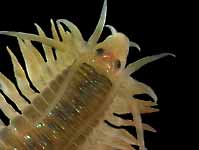Phylum Annelida
The plow is one of the most ancient and most valuable of man's inventions; but long before he existed the land was, in fact, regularly plowed and still continues to be thus plowed.... by earthworms. It may be doubted that there are any other animals which have played so important a part in the history of the world as have these lowly creatures.
-Charles Darwin
Ask anyone to name an annelid and the first response is usually an earthworm, the familiar annelids of garden soils, compost piles, fishhooks, and sidewalks after it rains. However, the vast majority of annelids are found in marine habitats, from intertidal algal mats to the deepest marine sediments. Another group of annelids, leeches, occur in freshwater and moist terrestrial environments.
Annelids as a group are commonly referred to as segmented worms. With ~12,000 species, Annelida is a diverse taxon, and this diversity evolved in conjuction with segmentation (metamerism). Annelid diversity manifests itself in many ways, but none is more obvious than their modes of feeding, which include suspension feeding, scavenging, herbivory and carnivory. The largest annelids, such as the giant earthworms of Australia, reach 3 meters in length, whereas the smallest are microscopic.
 |
Phylum Annelida
1.
Body segmented or metameric, bilaterally symmetrical, and wormlike
2.
Protostome characteristics include spiral
cleavage, trochophore larvae (when larvae are
present), and schizocoelous coelom formation
3.
Paired, epidermal setae
4.
Closed circulatory system
5.
Dorsal subpharyngeal ganglia and ventral nerve cord(s) with ganglia 6. Metanephridia (usually) or protonephridia |
The phylum is divided into three classes:
(1)
Polychaeta (many hairs); marine; paired parapodia with multiple setae on segments; well-differentiated head with specialized sense organs; mostly dioecious; no clitellum
(2)
Oligochaeta (few hairs); mostly freshwater and terrestrial; lack parapodia; few setae per segment; monoecious; clitellum present
(3) Hirudinea, the leeches; freshwater and terrestrial; flattened body with 33-34 segments; lack setae, lack parapodia; anterior and posterior suckers.
During the early evolution of animals 600 mya, the three habitats for animal life were the open sea, the surface of the sea floor, and the muddy substrate beneath the sea floor. As early animals evolved the ability for more complex locomotion, some burrowed into the soft mud of the sea floor. These were the segmented worms, as shown by fossil worm tunneling tracks dating back 540-650 million years. The ancestral annelids probably most closely resembled the living polychaetes. As members of this group moved into different habitats, populations slowly diverged into terrestrial and parasitic groups, giving rise to the oligochaeta and hirudinida.
A few annelids are important to humans as an indirect source of food, including earthworms (and marine relatives) used as fish bait, to till soil, and to convert organic matter to compost. Medicinal leeches are used today to promote the healing of tissue grafts and reattached fingers and other appendages.
Return to the Invertebrate
Zoology Homepage.